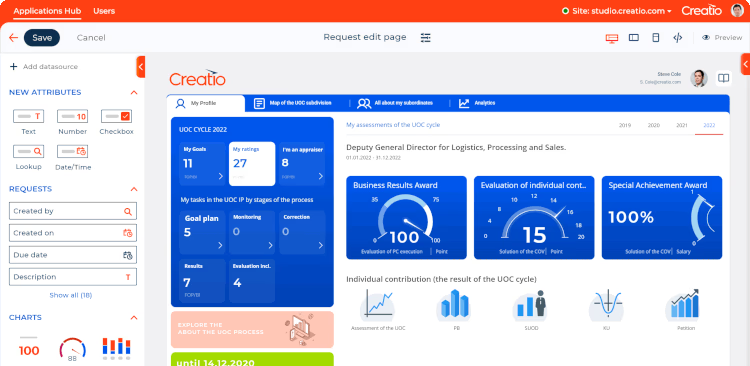No-Code Open Platform Database Development: Encouraging Businesses to Build Faster
No-Code Open Platform Database Development: Encouraging Businesses to Build Faster
Blog Article
Discover How Scalable Data Sources Can Be Utilized Without Coding to Boost Your Organization Operations
In today's hectic company setting, the capacity to take care of and assess information successfully is vital. no-code. Scalable data sources, especially when combined with no-code options, use a transformative method that equips non-technical individuals to enhance operations.
Understanding Scalable Data Sources
Scalable data sources are vital for modern-day business operations, permitting companies to effectively take care of increasing volumes of information without giving up efficiency. These databases are developed to adjust and grow to the changing needs of a business, guaranteeing that they can take care of bigger datasets and even more complex queries as organizational requirements advance.
Understanding scalable databases involves identifying their two primary types: vertical scaling and horizontal scaling. Vertical scaling, or "scaling up," entails including more power (CPU, RAM) to an existing web server to enhance performance. On the other hand, straight scaling, or "scaling out," entails adding more servers to distribute the load, which usually results in greater flexibility and mistake resistance.
An additional essential aspect is the architecture of scalable databases, which can be either relational or non-relational. Relational databases, such as MySQL and PostgreSQL, are structured and use SQL for inquiries, while non-relational data sources, like MongoDB and Cassandra, offer more flexibility with disorganized information.
Eventually, comprehending scalable databases is vital for businesses aiming to take advantage of information as a strategic property, allowing them to stay competitive in an increasingly data-driven setting.

Benefits of No-Code Solutions
Opening the capacity of no-code remedies empowers companies to simplify procedures and enhance productivity without the need for substantial shows knowledge. These systems enable non-technical individuals to develop, modify, and manage databases easily, hence equalizing access to innovation throughout groups.
Among the primary benefits of no-code services is their speed of application. Businesses can rapidly deploy applications and automate processes, dramatically decreasing the time invested in advancement cycles. This agility allows companies to respond immediately to market modifications and client demands, cultivating an one-upmanship.
Additionally, no-code platforms decrease reliance on IT departments for everyday tasks, enabling technological groups to concentrate on more complicated tasks that require specialized skills. This shift not just maximizes source allocation however likewise promotes advancement within the organization.
Cost-effectiveness is another advantage, as no-code services can reduce development and maintenance expenditures. By decreasing the requirement for coding expertise, companies can harness the capabilities of their existing labor force without the expenses of hiring additional employees.
Popular No-Code Data Source Devices
The increase of no-code solutions has caused the emergence of various database tools that satisfy organizations looking for efficiency and access. These devices empower customers with restricted technical proficiency to create, take care of, and control databases flawlessly.

Caspio stands apart for its capacity to construct web applications without any type of coding. It allows companies to create durable data sources and release applications rapidly, accommodating different sector demands. Propensity offers effective data and user-friendly user interfaces administration capacities, allowing companies to construct customized applications customized to their workflows.

Usage Instances in Organization Procedures
Exactly how can services take advantage of database tools to improve their operations? Scalable databases provide companies with effective abilities to manage and assess information without the demand for substantial coding understanding. These tools can simplify numerous company processes, inevitably bring about enhanced efficiency and performance.
One famous use situation is customer connection administration (CRM) Companies can utilize scalable data sources to track customer communications, preferences, and feedback, making it possible for customized communication and far better service. By centralizing this information, groups can collaborate extra successfully and respond to client needs in real-time.
One more significant application is supply administration. Companies can utilize no-code database tools to monitor stock degrees, track shipments, and projection need. This ensures optimal supply levels, minimizes waste, and reduces stockouts.
In addition, project administration can gain from scalable data sources by permitting teams to handle tasks, target dates, and resources in a combined platform. With real-time updates and data visualization, task managers can make informed choices.
Beginning With Execution
Executing scalable data sources in business procedures calls for a structured method to make certain effective integration and utilization. The initial step is to conduct a thorough requirements evaluation, recognizing specific business demands, information kinds, and anticipated development patterns. This fundamental understanding will certainly guide the option of the appropriate database service.
Next, select a straightforward, no-code data source platform that lines up with your operational goals. no-code. Lots of contemporary options supply instinctive interfaces, enabling non-technical customers to handle information properly. After picking a system, develop a clear information style that lays out just how information will certainly be arranged, accessed, and preserved
Training is essential; make sure that employee are geared up with the required skills to utilize the data source. Take into consideration giving tutorials or workshops to acquaint personnel with the system's functionalities.
Conclusion
To conclude, the integration of scalable data sources with no-code remedies provides significant advantages for organization procedures. These platforms encourage non-technical customers to effectively manage and assess information, helping with enhanced decision-making and partnership. By adopting devices such as Airtable and useful content Idea, companies visit site can improve processes and minimize dependence on IT sources. Eventually, leveraging these technologies can cause enhanced performance and operational performance, positioning organizations for sustained development in a competitive landscape.
One preferred no-code data source tool is Airtable, which combines the capability of a spreadsheet with the power of a data source.How can organizations leverage data source devices to enhance their operations? Organizations can utilize scalable data sources to track customer communications, preferences, and comments, making it possible for customized interaction and better service.Applying scalable databases in company operations calls for an organized approach to guarantee effective assimilation and utilization.In conclusion, the combination of scalable data sources with no-code services provides substantial benefits for organization operations.
Report this page